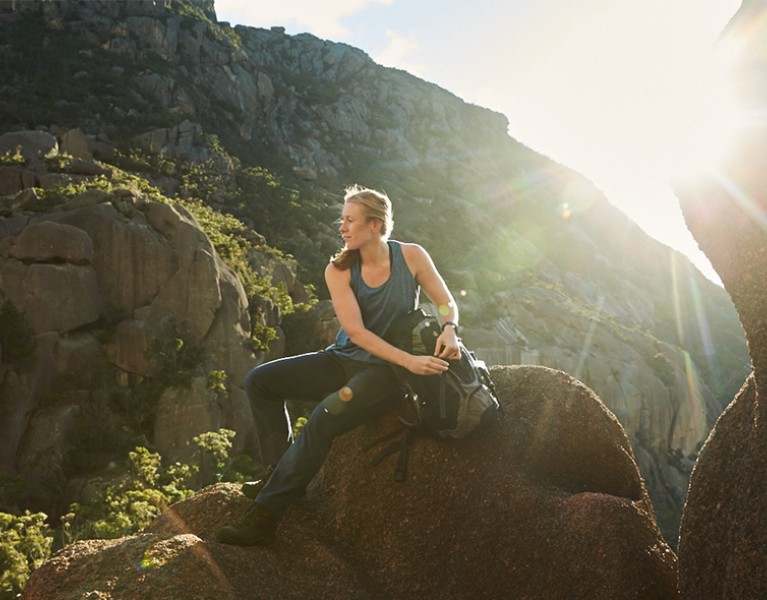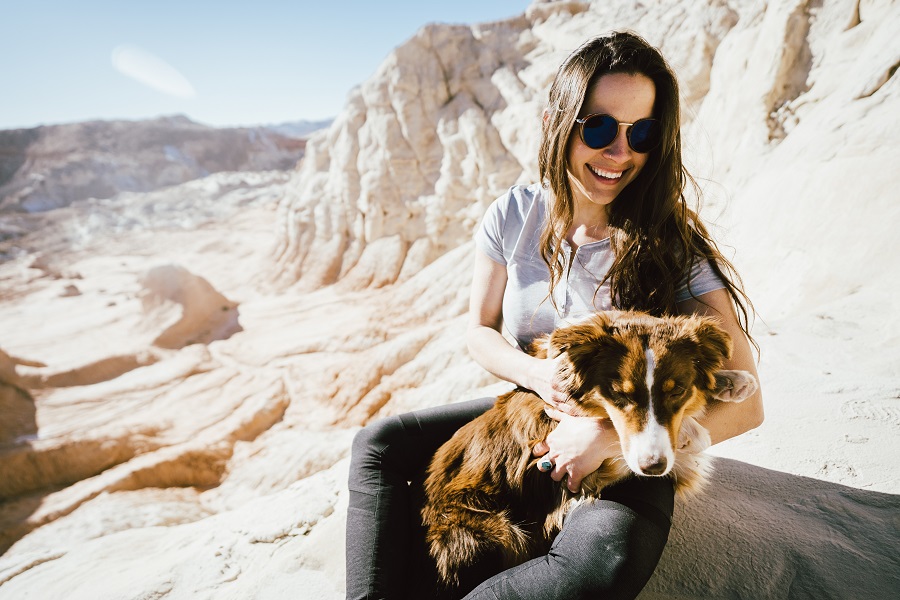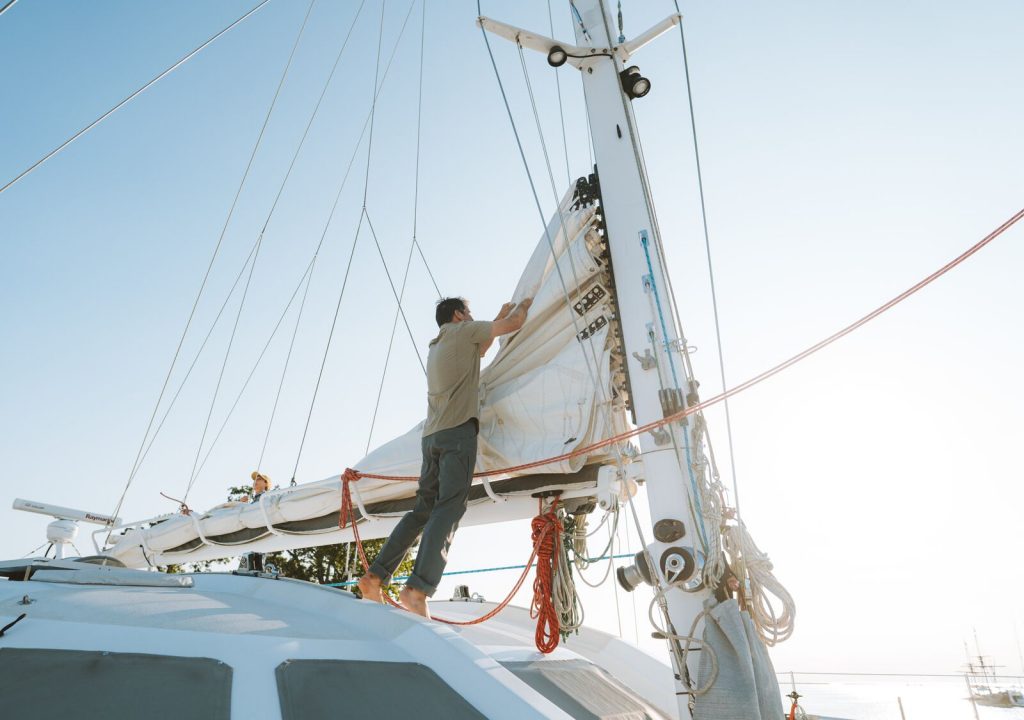- 1. What's the deal with UV radiation?
- 2. What's sun-protective clothing?
- 2.1. What is UPF rating?
- 2.2. Does black clothing protect you from the sun?
- 3. How to have a sun-safe outdoor adventure?
- 3.1. Step One: What to factor in when preparing for an outdoor activity?
- 3.2. Step Two: Come prepared!
- 3.3. Step Three: Bring the right sun-protection clothing!
- 3.4. A little UV ray of sunshine

What You Should Know About Sun-Protective Outdoor Clothing
Table of Contents [Show]
Close your eyes and imagine walking in the woods and the soft carpet made from branches and pine needles beneath your feet. You take a deep breath and recognize that familiar woodland smell of the fresh mountain air. The gentle wind sways the canopy, letting the sun's rejuvenating glow to touch your skin.
The sunscreen did its job; you applied it on your arms, legs, neck, and face, believing your clothing should protect the rest... But does it really?
The short answer - yes, to a point.
As the day passes and your outdoor activity continues, the comforting radiance quickly shifts from invigorating to unpleasant and exhausting. If you don't recognize the danger, you could easily get sunburnt, or worse.
It's time to talk about how you can enjoy your outdoor activities without needing to worry! Why is sun-protective clothing so important, and how exactly can your apparel help us shield skin cells from harmful UV rays, whether on a trail, mountainside, or on water?
What's the deal with UV radiation?
The ultraviolet (UV) rays are electromagnetic radiation which causes human skin to burn when exposed to its natural (sunlight) or man-made source. However, the danger doesn't end there. Over time, UV rays can cause serious trouble like sunburns, blisters, blemishes, and skin cancer.
While some sun exposure is necessary for good health and producing vitamin D, getting a suntan is not.
According to the American Cancer Society, there are three types of UV radiation:
- UVA - About 95% reach the ground, and they damage skin cells and cause them to age, but they can also play a part in some skin cancers.
- UVB - When the remaining 5% reach the ground, they damage the DNA in skin cells and cause sunburns and most skin cancers.
- UVC - The most powerful of the three, but rarely reach the ground since they react with ozone in our atmosphere. However, UVC rays are usually found in man-made sources like welding torches and tanning beds.
Those are nasty downsides, but luckily, these hazards are easily avoided with UPF rated clothes. Since sunlight is the big bad for every outdoor enthusiast, let's see how you can protect yourself with sun-protective clothing.

What's sun-protective clothing?
Sun-protective clothing keeps you safe from UV rays through fabrics with high UPF rating, dense weave, color, stretch, and wetness.
Wearing sun-protection clothing on your hiking trips, sailing journies or mountain climbs, helps prevent the above-mentioned severe consequences of prolonged sun exposure, as it blocks most of the sun's harmful UVA and UVB radiation.
Before you venture out in the great outdoors, the Skin Cancer Foundation suggests that you should know the UPF rating of all of the clothes you wear.
Uhm, sure, but can you please explain to me...
What is UPF rating?
Ultraviolet protection factor (or UPF) is a relatively new term, and it measures how well can a piece of fabric shield you against harmful ultraviolet radiation. Every piece of sun-protection clothing has a UPF rating; the higher the rating, the more protection you have - simple as that.
UPF labels range from:
- Good -15-24, blocks 93.3% – 95.9% of UV rays,
- Very Good - 25-39, blocks 96.0% – 97.4% of UV rays,
- Excellent - 40-50+, blocks 97.5% – 98+% of UV rays.
So, for example, if a summer shirt has a UPF rating of 50, it means that if 50 units of UV radiation falls on its fabric, only 1 will reach your skin.
Don't confuse UPF with sun protection factor (SPF), which measures how long you can be exposed to sunlight before getting burned.
Interested in helping raise sun safety awareness and taking part in “Don’t Fry Day”? Check out this article from the National Council on Skin Cancer Prevention.
Does black clothing protect you from the sun?
Wearing darker colors is not a good idea if you are looking to protect yourself from UV rays. According to Huntsman Cancer Institute:
Darker colors absorb more UV than lighter colors like whites and pastels.
For optimal sun-protection on a trail or on the water, you should consider bringing lighter, more vivid colors.
How to have a sun-safe outdoor adventure?
Exploring the great outdoors and the seemingly endless seas can sometimes be addictive. The best way to appreciate the lively wildlife or the untamable salt or fresh waters is to counter the downsides. Here are three steps to stay sun-safe:
Step One: What to factor in when preparing for an outdoor activity?
It is difficult to escape the sun out in the wilds, especially on deck when sailing, so it's a good idea to know the challenges that may lay ahead. How exposed you are to UV rays depends on several natural factors, some of which may vary from place to the other:
- Time of Day - Consider taking UV protection between 10 AM and 4 PM.
- Season - Sunlight is stronger during spring and summer.
- Altitude - The breathtaking mountainside hiking comes with its own danger. The higher you are, the more UV rays reach the ground.
- Cover - Hiking through a forest with dense foliage provides some level of sun protection. Having a sun-shade on your boat can also keep you safe.
- Clouds - UV rays pierce through all types of clouds.
- Reflection - Ultraviolet radiation can reflect off water, snow, sand, and even grass.
Note: Sailing, paddling, kayaking, or fishing are some of the activities which expose you to plenty of sun rays, and prolonged exposure can cause a sunburn.
- Wind - Cold mountain winds or fresh forest gusts can keep you cool and unaware of the harmful sunlight.
- Trail length - The longer the trail, the more exposed you are.
Tip: If you are hiking, sailing, or traveling outside of the United States, keep in mind that UV rays are stronger the closer your journey is to the equator.

Step Two: Come prepared!
In the great outdoors where every turn opens up a whole new world to explore, it's easy to push yourself to keep exploring. This is also true when you are out in the open sea or sailing on a lake.
Both can lead to both physical and mental exhaustion, and during summertime, it can be problematic. To make sure you are ready for your outdoor journey, here's a list of sun-protective essentials you should pack:
- Sunscreen: Protects your skin that isn't covered with clothing (exceptionally effective against water-reflected sun rays)
- Sunglasses: Protect your eyes from reflected and direct UV rays.
- Mobile phone: Use sun safety apps to check the UV index report so you can stay safe during the most dangerous time of the day.
- Water: Extensive sun exposure can lead to dehydration! Be sure to bring enough water for the journey.
- First Aid: Taking a pre-assembled kit helps you treat the most common injuries and ailments that can result from outdoor activities. Check out our article on how to make your own backcountry emergency kit!
Step Three: Bring the right sun-protection clothing!
Designed for prolonged sun exposure, KÜHL's SPF clothing comes hand in hand with top outdoor performance - whether you are in a forest, on the Rockies, or enjoying sailing. A double win for every outdoor enthusiast!
Hat: To protect your face, neck and hair, put on a wide-brimmed sun-protection hat like Sun Dagger™.
Top: A tightly woven, wicking long sleeve shirt like ExpeditionAir™ or Bandita™ 1/2 Zip Pullover with a UPF of 50 dries quickly and provides you much needed sun protection. If long sleeves are not your thing, then consider a more casual and equally UPF rated KÜHLDRY Crew™ or Juniper SS™.
Bottom: Look for lightweight pants like Konfidant™ Air or versatile Splash™ Roll-Up, both with excellent UPF of 50! If you prefer shorts that offer ultimate sun protection, consider stylish Navigatr™ or super comfortable Hörizn™.
A little UV ray of sunshine
UPF clothing is slowly gaining in popularity as people are more aware of the dangers of the sun. Wearing sun-protection clothes lets you counter the harmful UVA and UVB rays so you can truly enjoy all nature has to offer.
So grab your shades, put on a hat, and see you outside!


